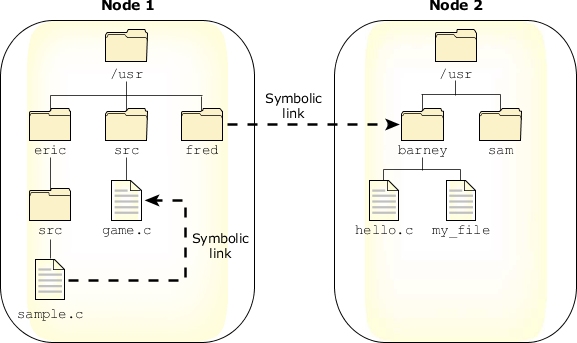
- #Symbolic linker os10.9.5 for mac os x#
- #Symbolic linker os10.9.5 mac os x#
- #Symbolic linker os10.9.5 full#
Those files are created at boot time by "/etc/rc.d/rc.local" script. "/etc/passwd" and "/etc/shadow" are symbolic links to "/tmp/passwd" and "/tmp/shadow". It is now time to start that "/usr/sbin/telnetd" server :) But wait.
#Symbolic linker os10.9.5 mac os x#
So … "recorder_test.cgi" potentially calls system("smbmount //%s/%s %s -o username=%s,password=%s") … Let's see if "password" parameter is properly escaped. My personal settings on OS X Mac OS X support for Windows Live Writer Is it safe to always run on a Macbook. Once the symlink has been created, this is how it looks in the File Explorer.
In main.cpp I can includeThe second path belongs to the actual file on your disk and is called Target. In an Xcode project (I'm using the latest version on OS 10.9 btw) I've out the Other Linker Flags to -lgmpxx -lgmp (which is very similar to what we had to do to set up GMP for our user on campus). The first path you see in the above command is where you will create your symlink. Rs485_control.cgi: RS485PresetControl::%s(), unexpected command mklink 'E:PathSymlinkFile.txt' 'F:RealFile.txt'. Recorder_test.cgi: smbmount //%s/%s %s -o username=%s,password=%s Let's focus on those files, and look for possibly unsecure calls.Īdv_sdcard.cgi: find "%s" -type f -name "*" |wc -l In my experience, this bug plagues all and every Linux-based embedded devices, ranging from the OrangeBox (now dead link) to DD-WRT. Let's look for compiled CGI that might be calling system(). However we are going to focus on a very specific bug: "semicolon injection". XmlBegin index.xsl home-left.lang index.lang usr/sbin/telnetd 1>/dev/null 2>/dev/null consistency (POSIX file attributes, Hardlinks, Symlinks, Data Fork and Resource Fork, etc.).
#Symbolic linker os10.9.5 for mac os x#
According to copyright strings, the camera itself is built around the Prolific PL-1029 "System On a Chip". Many CGI files under "/var/script :) Paragon NTFS NTFS for Mac OS X 9.5 Instructions Manualzz.
#Symbolic linker os10.9.5 full#
We now have full read access to the firmware, which leads to interesting discoveries. Orange version I have downloaded the last Orange3 version for Mac (Orange3-3.5.0.dmg) Expected behavior Installed it as described and tried to open it using right click, open. $ sudo mount -o loop,ro cramfs /mnt/loop/īin dev etc lib linuxrc mnt opt proc sbin scripts tmp usr var Actual offset may vary - depending of the firmware localization (D-Link provides regional builds of the same version). Nevertheless we gained some insights about memory layout, and we know that a CramFS filesystem is used.ĬramFS "magic" bytes are 0x28cd3d45 - they are very easy to locate within the firmware (beware of endianness). # tarLine will be replaced with a real number by Makefile To avoid that, I rewrote it to use rule replacements on the symbolic representation of the XML instead of string replacement.The shell script is very small - interesting parts are the following:īLOCKS="norboot.bin(0x10000,65536),vmlinuz(0圆0000,1048576),cram_image(0x160000,0x5E0000),autoboot.bin(0x2000,8192)" The following screenshot shows how Oracle VM VirtualBox, installed on an Apple Mac OS X computer, is running Windows Server 2016 in a virtual machine window.

Looking at the generated SVG as XML, it looks like the "text" elements that represent the labels on the axes in the SVG generated by M9 have somehow been replaced by "symbol" elements in M10.1.įWIW, this was done on a machine running Mac OS 10.9.5.ĮDIT: I tried using this svgExport routine, and it resulted in an SVG file which had the axes and tick labels displaying correctly, but didn't actually show the curve.Īfter some experimentation, I discovered that the issue preventing svgExport from working was that string replacements which add attributes caused multiple copies of the width and height attributes to be inserted. While I don't have Mathematica 10.0 installed on this machine, I do have Mathematica 9, and this command works correctly in 9.

Use intermediate symbolic links as aliases between the configuration files. The SVG file was produced with the following command: Export["~/Desktop/test-m10-1.svg", Anytime that a hardware resource (such as a channel, CF link, or sysplex time. Here is an screenshot of such a mangled plot: priority this is linked to their position in the vector table. However, when I tried to do this recently, I found that the text in the plot axes was rendered completely illegible, with all the characters being much too large, and all characters in a text element piling up on one another. In the past, I was able to export Mathematica plots as SVG files with relative ease.


 0 kommentar(er)
0 kommentar(er)
